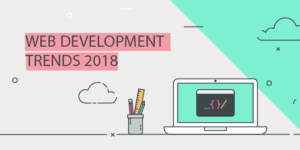 Another year winds down and with close to 1.8 billion websites, it is becoming more evident that internet is the now predominant platform for engagement.
Another year winds down and with close to 1.8 billion websites, it is becoming more evident that internet is the now predominant platform for engagement.
Mobile optimized websites, responsive sites to many enterprise-grade websites, its all about uniqueness to stay relevant to times, audience and trends.
In simple terms, web development trends emerge and evolve in tandem with user’s expectations and requirements. In response to these changes, many programming languages and frameworks are gaining importance. Additionally, with the increasing usage of mobile internet, web developers are always under tremendous pressure to equip websites that hosts all the advanced features.
After going through the industry research, here are some of our hot-picks from 2018’s most popular website development trends:
- JavaScript Framework and Libraries: The previous year, 2017 saw an upward curve with regards to use of JavaScript for web development. The vast and flexible libraries and JavaScript frameworks like React and Angular made it the most popular programming language of the year, confirms a report by Stack Overflow.
- Rise of Accelerated Mobile Pages: Accelerated mobile pages or AMPs are Google’s open-source projects that has given a jumpstart to popular social media platforms like Pinterest, Bing and Twitter. The idea behind AMPs are to boost site speed and UX features as well as optimizing the performance of web content and mobile ads. The rise of AMPs grew concurrently with the growth of mobile-friendly and responsive websites. And according to market research reports, in the U.S. nearly seven percent of the website traffic is generated by AMPs.
- Chatbots Augmenting Customer Services: Chatbots are the new way to interact with customers directly and provide them answers or responses to their queries in real-time. The biggest advantage of chatbots in customer support is that it curbs the need to employ a customer services personnel to assist customers from any part of the world, 24/7. Excerpts from nearly six chatbot surveys of 2018 about 60 percent of online users have used chatbot services to interact with business in the last one year.
- AI-powered Websites: Industry giants like Facebook and Google were the among the firsts to enhance the UX of their sites with AI. AI-powered tools and advancements that can study facts, gather data and analyse insights help create functional websites built to handle website traffic, exceed user expectations and deliver seamless user experience. Additionally, platforms like GoDaddy, Bookmark, The Gird and few others have started to dabble with artificial design intelligence or ADI to adopt web design trends for better personalization.
- Static Site Generator: Static site generators are bunch of pages in basic HTML files. They are used to build server-based websites on desktop device and create site into static files. Static site generators are popular concepts on web development and almost all programming languages that are used to deliver sites with dynamic functionalities and features. It helps seamlessly convert text into website content, blogs and metadata and increases the loading speed and performance of the site.
- Development of Progressive Web Apps: Progressive web apps or PWAs are application platforms that allow users to access offline, push notifications and perform actions that are available in native mobile apps. The primary function of PWAs is that they help users skip searching or looking up for the websites and directly access it by quickly loading web pages that are stored as cache. It is mostly useful for users who prefer to work offline with affecting the quality of their performance.
- Growth of e-Commerce Websites and Apps: e-commerce web development outpaced its predecessors in terms of revenue generation and growth rate. Many custom e-Commerce development companies and web developers are exploiting the functionalities and features that platforms like Magento, Shopify offer for better personalization and customization. Notable giants in the e-Commerce business are created custom-built, responsive and mobile-friendly websites that compete in terms of performance, superior UX/UI and customer engagement.
- Integration with IoT: Many advancements in technology like IoT have amassed attention and interest with a predicted growth rate of 31.72 percent CAGR by 2019. After allowing businesses and end-users manage tasks and save time with the helps devices that are linked to the internet, IoT is slated to carry forth similar advantages in the web development space.
- Leveraging AR and VR: Web developers and many providers of customer e-Commerce website development solutions have cast a deeper glance at the advantages of AR and VR in delivering superior user experiences beyond the screens on the devices. Content are blend seamlessly to reality with the helps of AR for providing a whole new experience for users browsing the website. While VR is being leveraged in gaming sites and delivering video content.
- PHP and Laravel Framework: Voted unanimously as the most popular sever-side programming language, PHP frameworks empower web developers to create complex websites with high security features and develop application platforms faster than ever. Google survey on most searched framework finds Laravel as the framework used for major PHP projects. Laravel boasts of rapid app development, high abstraction and ability to manage files and code. It also has strong encryption features and variety of out-of-the-box functionalities.
The web development industry witnessed great technological developments and collaborations that are here to stay. The list in technical sense, seems endless and the trends in design and development help businesses to set new standards and battle hard for greater leads and conversion.
Overall, the industry is shaping up to cater to the advanced needs of customers for better business outcomes, loyalty and success.











